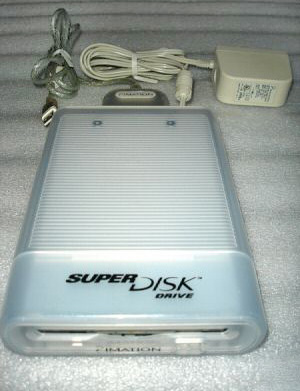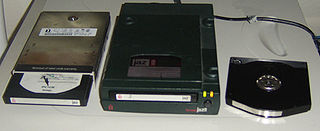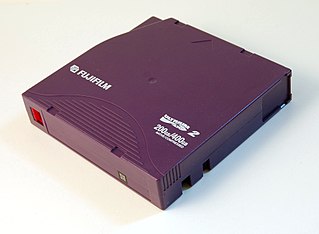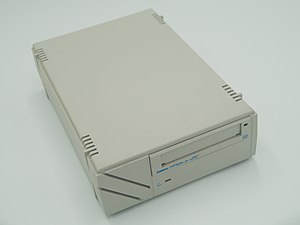
A tape drive is a data storage device that reads and writes data on a magnetic tape. Magnetic tape data storage is typically used for offline, archival data storage. Tape media generally has a favorable unit cost and a long archival stability.

The SuperDisk LS-120 is a high-speed, high-capacity alternative to the 90 mm (3.5 in), 1.44 MB floppy disk. The SuperDisk hardware was created by 3M's storage products group Imation in 1997, with manufacturing chiefly by Matsushita.

The Zip drive is a removable floppy disk storage system that was introduced by Iomega in late 1994. Considered medium-to-high-capacity at the time of its release, Zip disks were originally launched with capacities of 100 MB, then 250 MB, and finally 750 MB.
SyQuest Technology, Inc. (Nasdaq: SYQT) was an early entrant into the hard disk drive market for personal computers. The company was founded on January 27, 1982 by Syed Iftikar who had been a founder of Seagate, along with Ben Alaimo, Bill Krajewski, Anil Nigam and George Toldi. Its earliest products were the SQ306R, a 5 MB 3.9" (100 mm) cartridge disk drive and associated Q-Pak cartridge for IBM XT compatibles. Subsequently a non-removable medium version was announced, the SQ306F.

Floptical refers to a type of floppy disk drive that combines magnetic and optical technologies to store data on media similar to standard 3+1⁄2-inch floppy disks. The name is a portmanteau of the words "floppy" and "optical". It refers specifically to one brand of drive and disk system, but is also used more generically to refer to any system using similar techniques.

Iomega produced external, portable, and networked data storage products. Established in the 1980s in Roy, Utah, United States, Iomega sold more than 410 million digital storage drives and disks, including the Zip drive floppy disk system. Formerly a public company, it was acquired by EMC Corporation in 2008, and then by Lenovo, which rebranded the product line as LenovoEMC, until discontinuation in 2018.
REV is a removable hard disk storage system from Iomega.

Digital Data Storage (DDS) is a computer data storage technology that is based upon the Digital Audio Tape (DAT) format that was developed during the 1980s. DDS is primarily intended for use as off-line storage, especially for generating backup copies of working data.

The Jaz drive was a removable hard disk storage system sold by the Iomega company from 1995 to 2002.

Quarter inch cartridge tape is a magnetic tape data storage format introduced by 3M in 1972, with derivatives still in use as of 2016. QIC comes in a rugged enclosed package of aluminum and plastic that holds two tape reels driven by a single belt in direct contact with the tape. The tape was originally 1⁄4 inch (6.35 mm) wide and anywhere from 300 to 1,500 feet long. Data is written linearly along the length of the tape in one track, or written "serpentine", one track at a time, the drive reversing direction at the end of the tape, and each track's data written in the opposite direction to its neighbor. Since its introduction, it has been widely used, and many variations exist. There is a QIC trade association that publishes QIC standards which include interfaces and logical formats. To a very large extent it was the efficiency and openness of this organization which encouraged hardware and software developers to use this type of drive and media.

Advanced Intelligent Tape (AIT) is a discontinued high-speed, high-capacity magnetic tape data storage format developed and controlled by Sony. It competed mainly against the DLT, LTO, DAT/DDS, and VXA formats. AIT uses a cassette similar to Video8. Super AIT (SAIT) is a higher capacity variant using wider tape in a larger, single-spool cartridge. Both AIT and SAIT use the helical scan method of reading and writing the tape.

Linear Tape-Open (LTO) is a magnetic tape data storage technology originally developed in the late 1990s as an open standards alternative to the proprietary magnetic tape formats that were available at the time. Hewlett Packard Enterprise, IBM, and Quantum control the LTO Consortium, which directs development and manages licensing and certification of media and mechanism manufacturers.

Travan is an 8 mm magnetic tape cartridge design developed by the 3M company, used for the storage of data in computer backups and mass storage. Over time, subsequent versions of Travan cartridges and drives have been developed that provide greater data capacity, while retaining the standard 8 mm width and 750' length. Travan is standardized under the QIC body. HP Colorado, Iomega DittoMax and AIWA Bolt are proprietary versions of the Travan format.
The Sony HiFD was a high-capacity floppy disk system developed by Sony and Fujifilm and introduced in late 1998. Development and sale of the drives was discontinued by early 2001.
The PocketZip is a medium-capacity floppy disk storage system that was made by Iomega in 1999 that uses proprietary, small, very thin, 40 MB disks. Its relation to the original Zip drive and disk is the floppy medium and relatively much higher capacity than standard floppy disks. It was known as the "Clik!" drive until the click of death class action lawsuit regarding mass failures of Iomega's Zip drives. Thenceforth, it was renamed to PocketZip. A 100 MB Pocket Zip drive version had been in the works, was intended to be backwards compatible with the 40 MB disks, but ended up being vaporware and PocketZip itself would be discontinued as well.
Magnetic-tape data storage is a system for storing digital information on magnetic tape using digital recording.

The IBM 3590 is a series of tape drives and corresponding magnetic tape data storage media formats developed by IBM. The first drive, having the IBM product number 3590, was introduced in 1995 under the nickname Magstar. The 3590 series of tape drives and media are not compatible with the IBM 3592 line of drives that replaced it. They can store up to 60 GB of data (uncompressed). This family superseded the IBM 3480 Family of tape drives popular in 1980s and 1990s.

The IBM 3592 is a series of tape drives and corresponding magnetic tape data storage media formats developed by IBM. The first drive, having the IBM product number 3592, was introduced under the nickname Jaguar. The next drive was the TS1120, also having the nickname Jaguar. As of November 2018, the latest and current drive is the TS1160 Gen 6. The 3592 line of tape drives and media is not compatible with the IBM 3590 series of drives, which it superseded. This series can store up to 20 TB of data (uncompressed) on a cartridge and has a native data transfer rate of up to 400 MB/s.

A game backup device, informally called a copier, is a device for backing up ROM data from a video game cartridge to a computer file called a ROM image and playing them back on the official hardware. Recently flash cartridges, especially on the Game Boy Advance and Nintendo DS platforms, only support the latter function; they cannot be used for backing up ROM data. Game backup devices also make it possible to develop homebrew software on video game systems. Game backup devices differ from modchips in that modchips are used in conjunction with systems that use generally available media such as CDs and DVDs, whereas game backup devices are used with systems that use cartridges.

The Apple Tape Backup 40SC is an external, SCSI-interfaced, 1⁄4-inch (6.35 mm) QIC, mini-cartridge tape drive. It was first introduced by Apple Inc. in 1987 and discontinued in 1994. The drive came bundled with Retrospect backup software. The drive is also compatible with the tape software included with A/UX.















